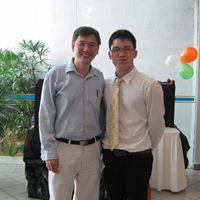Changhua Chen
Deceased
from Arcadia, CA
- Also known as:
-
- Jonathan Chen
- Chung H Chen
- Chen G Chen
- Cheng Chen
- Hsin Chen Chung
- Hua Chen Chang
- Ching H Cheng
Changhua Chen Phones & Addresses
- Arcadia, CA
- San Jose, CA
- Provo, UT
- Salt Lake City, UT
- Irvine, CA
- Los Angeles, CA
- Sunnyvale, CA
- 4685 Albany Cir APT 122, San Jose, CA 95129
Us Patents
-
Epitaxial Material Grown Laterally Within A Trench And Method For Producing Same
view source -
US Patent:6500257, Dec 31, 2002
-
Filed:Apr 17, 1998
-
Appl. No.:09/062028
-
Inventors:Shih-Yuan Wang - Palo Alto CA
Changhua Chen - San Jose CA
Yong Chen - Mountain View CA
Scott W. Corzine - Sunnyvale CA
R. Scott Kern - San Jose CA -
Assignee:Agilent Technologies, Inc. - Palo Alto CA
-
International Classification:C30B 2300
-
US Classification:117 95, 438479
-
Abstract:An epitaxial material grown laterally in a trench allows for the fabrication of a trench-based semiconductor material that is substantially low in dislocation density. Initiating the growth from a sidewall of a trench minimizes the density of dislocations present in the lattice growth template, which minimizes the dislocation density in the regrown material. Also, by allowing the regrowth to fill and overflow the trench, the low dislocation density material can cover the entire surface of the substrate upon which the low dislocation density material is grown. Furthermore, with successive iterations of the trench growth procedure, higher quality material can be obtained. Devices that require a stable, high quality epitaxial material can then be fabricated from the low dislocation density material.
-
Ingan/Algan/Gan Multilayer Buffer For Growth Of Gan On Sapphire
view source -
US Patent:6630695, Oct 7, 2003
-
Filed:Jul 8, 2002
-
Appl. No.:10/191886
-
Inventors:Changhua Chen - San Jose CA 95129
James Dong - Claremont CA 91711
Heng Liu - Arcadia CA 91007 -
International Classification:H01L 3300
-
US Classification:257190, 257103
-
Abstract:A GaN based three layer buffer structure disposed on a substrate, and having a GaN layer disposed on the three layer buffer structure, the GaN layer serving as a platform for growth of a light emitting structure thereon.
-
Minority Carrier Semiconductor Devices With Improved Reliability
view source -
US Patent:6794731, Sep 21, 2004
-
Filed:Oct 9, 1998
-
Appl. No.:09/169218
-
Inventors:Stephen A. Stockman - San Jose CA
Daniel A. Steigerwald - Cupertino CA
Changhua Chen - San Jose CA -
Assignee:Lumileds Lighting U.S., LLC - San Jose CA
-
International Classification:H01L 29167
-
US Classification:257610, 257 13, 257 79, 257 80, 257 82, 257103, 257918
-
Abstract:A method for improving the operating stability of compound semiconductor minority carrier devices and the devices created using this method are described. The method describes intentional introduction of impurities into the layers adjacent to the active region, which impurities act as a barrier to the degradation process, particularly undesired defect formation and propagation. A preferred embodiment of the present invention uses O doping of III-V optoelectronic devices during an epitaxial growth process to improve the operating reliability of the devices.
-
Light Emitting Diode
view source -
US Patent:6888171, May 3, 2005
-
Filed:Dec 22, 2000
-
Appl. No.:09/748801
-
Inventors:Heng Liu - Los Angeles CA, US
Changhua Chen - Los Angeles CA, US -
Assignee:Dallan Luming Science & Technology Group Co., Ltd. - Dalian
-
International Classification:H01L027/15
H01L029/12
H01L029/40 -
US Classification:257 99, 257 79, 257613, 257615, 257612, 257624, 257626
-
Abstract:A semi-conductor light emitting diode includes closely spaced n and p electrodes formed on the same side of a substrate to form an LED with a small foot-print. A semi-transparent U shaped p contact layer is formed along three sides of the top surface of the underlying window layer. The p electrode is formed on the p contact layer centered on the closed end of the U shaped layer. An n contact layer is formed on an n cladding layer and centered in the open end of the U of the p contact layer. The n electrode is formed on the n contact layer. The n and p electrodes are electrically isolated from one another by either a trench or an insulator, situated between the electrodes.
-
Formation Of Ohmic Contacts In Iii-Nitride Light Emitting Devices
view source -
US Patent:6914272, Jul 5, 2005
-
Filed:Nov 24, 2003
-
Appl. No.:10/721440
-
Inventors:Werner K. Goetz - Palo Alto CA, US
Michael D. Camras - Sunnyvale CA, US
Changhua Chen - San Jose CA, US
Gina L. Christenson - Sunnyvale CA, US
R. Scott Kern - San Jose CA, US
Chihping Kuo - Milpitas CA, US
Paul Scott Martin - Pleasanton CA, US
Daniel A. Steigerwald - Cupertino CA, US -
Assignee:Lumileds Lighting U.S., LLC - San Jose CA
-
International Classification:H01L033/00
-
US Classification:257123, 257 79, 257 86, 257102, 257103, 313506
-
Abstract:P-type layers of a GaN based light-emitting device are optimized for formation of Ohmic contact with metal. In a first embodiment, a p-type GaN transition layer with a resistivity greater than or equal to about 7 Ωcm is formed between a p-type conductivity layer and a metal contact. In a second embodiment, the p-type transition layer is any III-V semiconductor. In a third embodiment, the p-type transition layer is a superlattice. In a fourth embodiment, a single p-type layer of varying composition and varying concentration of dopant is formed.
-
Formation Of Ohmic Contacts In Iii-Nitride Light Emitting Devices
view source -
US Patent:20020008243, Jan 24, 2002
-
Filed:Jan 5, 2001
-
Appl. No.:09/755935
-
Inventors:Werner Goetz - Palo Alto CA, US
Michael Camras - Sunnyvale CA, US
Changhua Chen - San Jose CA, US
Xiaoping Chen - San Jose CA, US
Gina Christenson - Sunnyvale CA, US
R. Kern - San Jose CA, US
Chihping Kuo - Milpitas CA, US
Paul Martin - Pleasanton CA, US
Daniel Steigerwald - Cupertino CA, US -
International Classification:H01L027/15
-
US Classification:257/079000
-
Abstract:P-type layers of a GaN based light-emitting device are optimized for formation of Ohmic contact with metal. In a first embodiment, a p-type GaN transition layer with a resistivity greater than or equal to about 7 cm is formed between a p-type conductivity layer and a metal contact. In a second embodiment, the p-type transition layer is any III-V semiconductor. In a third embodiment, the p-type transition layer is a superlattice. In a fourth embodiment, a single p-type layer of varying composition and varying concentration of dopant is formed.
-
Formation Of Ohmic Contacts In Iii-Nitride Light Emitting Devices
view source -
US Patent:20050167693, Aug 4, 2005
-
Filed:Mar 30, 2005
-
Appl. No.:11/095854
-
Inventors:Werner Goetz - Palo Alto CA, US
Michael Camras - Sunnyvale CA, US
Changhua Chen - San Jose CA, US
Xiaoping Chen - San Jose CA, US
Gina Christenson - Sunnyvale CA, US
R. Kern - San Jose CA, US
Chihping Kuo - Milpitas CA, US
Paul Martin - Pleasanton CA, US
Daniel Steigerwald - Cupertino CA, US -
International Classification:H01L021/00
H01L033/00 -
US Classification:257103000, 438022000
-
Abstract:P-type layers of a GaN based light-emitting device are optimized for formation of Ohmic contact with metal. In a first embodiment, a p-type GaN transition layer with a resistivity greater than or equal to about 7 Ω cm is formed between a p-type conductivity layer and a metal contact. In a second embodiment, the p-type transition layer is any III-V semiconductor. In a third embodiment, the p-type transition layer is a superlattice. In a fourth embodiment, a single p-type layer of varying composition and varying concentration of dopant is formed.
-
Minority Carrier Semiconductor Devices With Improved Stability
view source -
US Patent:59090510, Jun 1, 1999
-
Filed:Feb 18, 1997
-
Appl. No.:8/802183
-
Inventors:Stephen A. Stockman - San Jose CA
Daniel A. Steigerwald - Cupertino CA
Changhua Chen - San Jose CA -
Assignee:Hewlett-Packard Company - Palo alto CA
-
International Classification:H01L 3300
H01L 29167 -
US Classification:257610
-
Abstract:A method for improving the operating stability of compound semiconductor minority carrier devices and the devices created using this method are described. The method describes intentional introduction of impurities into the layers adjacent to the active region, which impurities act as a barrier to the degradation process, particularly undesired defect formation and propagation. A preferred embodiment of the present invention uses O doping of III-V optoelectronic devices during an epitaxial growth process to improve the operating reliability of the devices.
Resumes

Changhua Chen
view source
Changhua Chen
view source
Chen Changhua
view source
Changhua Chen
view source
Derek Chen Changhua
view sourceFriends:
Zhang Ziqiang, Darryl Chan, Jennifer Tay Peiyu, Defeng Lin, Tan Zhen Hui
Youtube
Googleplus

Changhua Chen
Get Report for Changhua Chen from Arcadia, CADeceased





